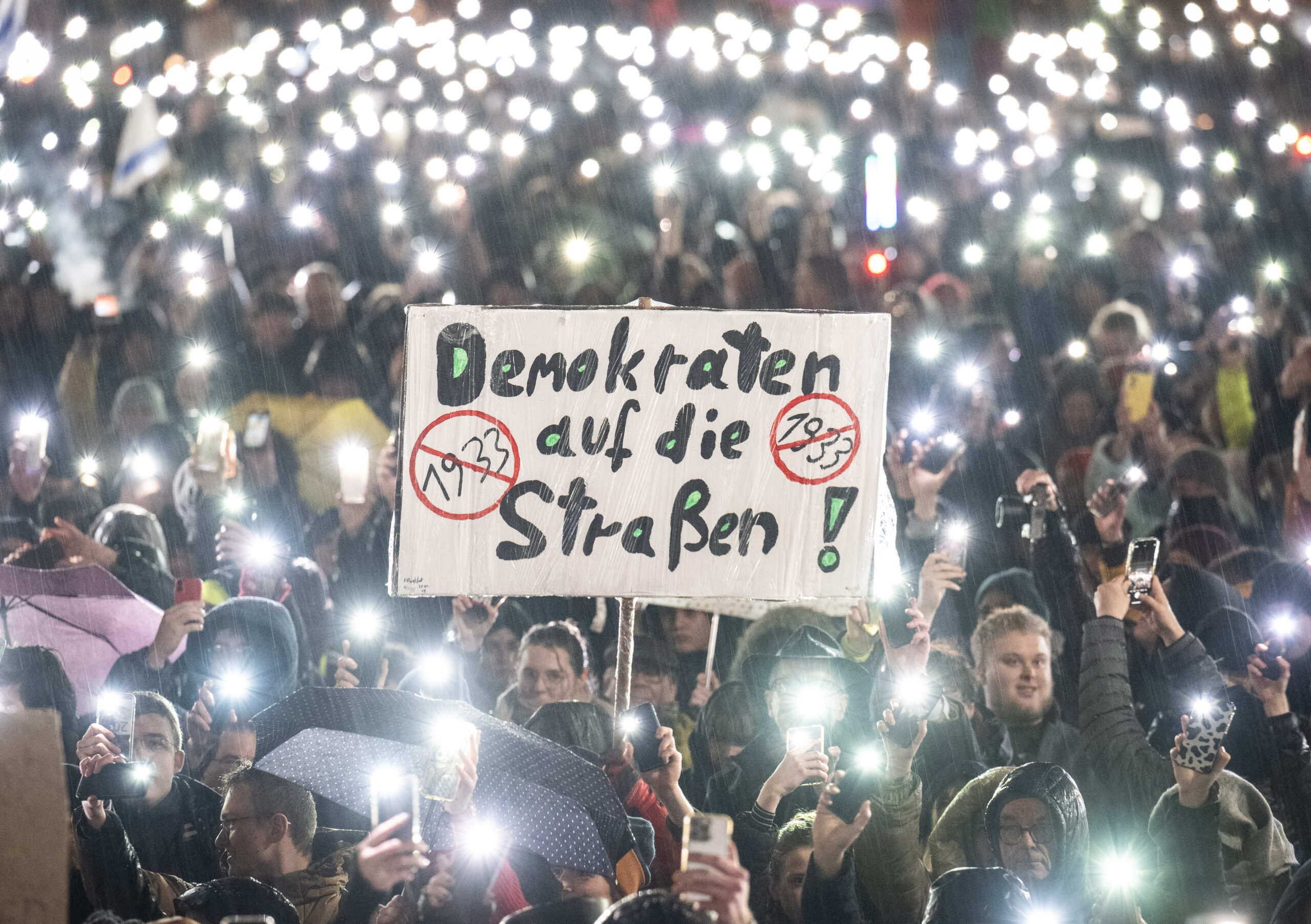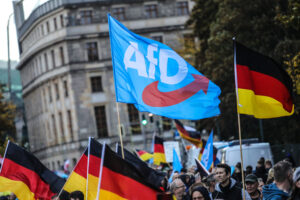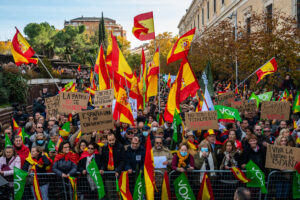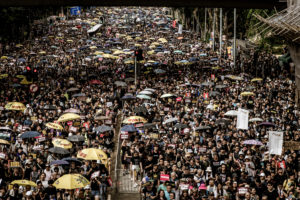
Hundreds of thousands of Germans are taking to the streets in protest against the country’s far-right parties. Will it shift the tide or leave Germany further divided?
January 2024
For a third consecutive week, hundreds of thousands of Germans have taken to the streets to protest the far-right Alternative for Germany (AfD) party and its policies. The numbers surged — to more than a million citizens in more than a hundred towns and cities across the country — after recent revelations about a secret far-right gathering where attendees, including AfD members, discussed plans to deport millions of foreigners or foreign-born citizens.
This past weekend, on January 28, around a hundred-thousand people marched through the northern city of Hamburg in support of “diversity and our democracy” and against the AfD. A day earlier, in Düsseldorf, a hundred thousand had raised their voices under the banner “Against the AfD, we will not remain silent!” The weekend before that, up to a hundred-thousand demonstrators showed up in Munich for the “United Against the Right” march — far exceeding organizers’ expectations and forcing them to cancel the event. The same thing also happened in Hamburg that weekend.
Most of the protests are being organized by civil society organizations. But large corporations, trade unions, and churches have embraced the cause as well. Even members of the federal government have joined the ranks, with German chancellor Olaf Scholz participating in a protest in his hometown of Potsdam.
This mobilization qualifies as one of the largest citizen movements in recent German history, drawing parallels to the peaceful revolution in East Germany in 1989. “The center is standing up,” commented Green Party leader Ricarda Lang. Some observers have described the protests as a “wake-up call” or even, as political scientist Claus Leggewie put it, a “reclaiming of the street,” while the progressive newspaper Taz, on X (Twitter), hailed the “coming of spring.”
Protesters clearly come from different walks of life, but the extent to which the protests actually reflect society as a whole is uncertain. One columnist for Germany’s flagship liberal weekly Zeit described the turnout as “bourgeois, white, privileged, bio-Germans from the city center.” Another critic noted (also in Zeit) that visible minorities were notably missing in a sea of “many white people.”
The left-of-center bias among organizers is indisputable. Some of the largest protests are being planned by Fridays for Future, a youth climate-activist group, or open-border groups, and in some cases these organizations seem hesitant to include even moderately conservative voices.
The initiator behind the Munich march, Lisa Poettinger, declared that representatives of the state’s governing party, the Christian Social Union (CSU), were not welcome to join, explaining that she had “no desire for right-wingers of any kind.” And in the West German city of Krefeld, a civil society alliance has called for a demonstration but initially excluded Germany’s Free Democrats — who form part of the Berlin traffic-light coalition of Social Democrats, Greens, and Liberals — as “too right-wing.” The suspicion seems mutual, though, with some in the conservative camp voicing concerns about joining protests against “the right” in general.
Perhaps such squabbles are inevitable in any grassroots action. But they do raise questions about how long the anti–right-wing coalition can last.
Another question is of momentum. Protests of this magnitude are notoriously difficult to maintain, and public support could soon dissipate. For now, however, protests continue unabated, and they are spilling over into Switzerland and Austria, with rallies in Vienna, Innsbruck, and Salzburg.
The biggest question remains what the protests will achieve. Recent months have seen an unprecedented rise of the AfD, which is not only polling as the second strongest party in the country but also leads the polls in three East German states with elections later this year.
Will the protests shift the tide? Protesters hope that the rallies will push AfD voters to reconsider their stance, with the far right’s positions now prominently criticized in public debates. But this may not work when confronting a movement fundamentally opposed to the supposed mainstream.
At least in terms of party membership, the protests seem to have had an opposite effect so far. Applications to join the far right are showing a clear uptick, with eight-thousand currently on hold because the party lacks the capacity to process so many incoming requests. Others are getting a boost, too: Conservatives and center-left parties are seeing renewed interest in membership.
A somewhat positive picture may be emerging in opinion polls. The first poll since the protests started showed a drop in support for the AfD from 23 to 21.5 percent. While not negligible, this change is still within the margin of error, pointing at deep-seated dissatisfaction with the Berlin government among a considerable share of German voters.
A German Winter of Discontent
German authorities rarely welcome mass protests. The anti-AfD protests, however, are an exception to the rule since in many ways they come at an opportune time for Berlin’s embattled government coalition.
A sluggish economy, high cost of living, and substantial increases in energy costs — partly due to the war in Ukraine — are one driver of discontent. Coalition infighting between Social Democrats, pro-business Liberals, and the Greens, alongside a perceived lack of political leadership from German chancellor Scholz and unpopular energy policies, are another. The combined effect has been devastating.
Only 31 percent of Germans currently support the traffic-light coalition. In East German states, it is conceivable that none of the current coalition parties will be represented in future regional parliaments. A weekend poll from Thuringia found that all three parties currently in power in Berlin would gain a combined total of 14 percent in state elections this fall, with the AfD emerging as the strongest party with 31 percent.
Against this backdrop, anti-AfD activism seems like a welcome reprieve for a government confronted with shrinking support and growing opposition.
In the weeks leading up to the current anti-AfD demonstrations, a surge of farmer protests against subsidy cuts attracted national attention. Protests have persisted despite government concessions, with hundreds of tractors blocking the port of Wilhelmshaven on Monday, and they are set to continue throughout this week.
Even with slight shifts in political allegiances, will current protests change the long-term prospects of the Berlin coalition?
One complicating factor is the further fragmentation of the German party system. Three weeks ago, former Left party leader Sahra Wagenknecht established a new political movement, Bündnis Sahra Wagenknecht (BSW), supporting a combination of redistributive economic policies, tougher positions on migration, and a critical approach to supporting Ukraine. With this policy mix, the party, which just held its first official convention in Berlin in preparation for the upcoming European Elections, does not fit neatly into left-right categorizations. While currently polling between 7 and 14 percent nationwide — impressive for a new movement — Wagenknecht’s rise has not significantly diverted support from the AfD. Instead, her party has mobilized former nonvoters while also gaining considerable support from former left-wing voters.
Complicating matters further, yet another new party is on the horizon. Hans-Georg Maassen, the former head of Germany’s domestic security agency and erstwhile Christian Democrat, is shaping his own brand of ultraconservatism called the Union of Values, or WerteUnion. At present, the group’s electoral performance is difficult to gauge, but up to 15 percent of voters are considering supporting the party. And most recently, activists close to Turkish president Recep Tayyip Erdogan have taken steps to establish a Democratic Alliance for Diversity and Awakening, specifically targeting Germans with Turkish roots ahead of the European elections.
In some ways, increased political fragmentation in Germany is echoing developments elsewhere in Europe. In the German case, however, persisting taboos against forming coalitions with Maassen’s far right or Sarah Wagenknecht’s movement may ultimately result in fewer — not more — government options, at least on the national level.
Given a lack of alternatives, the most realistic scenario for a future coalition government in Berlin now appears to be a renewed Grand Coalition between Christian and Social Democrats. Such coalitions have kept Germany on a centrist course in the past, but also inevitably further strengthened the political fringes. One thing is clear: With the far-right growing, elections on the horizon, and the political system increasingly fragmenting, Germany’s winter of discontent may be followed by an equally turbulent summer — even after the current wave of protests has passed.![]()
Michael Bröning is a political scientist and a member of the basic-value commission of the German Social Democratic Party.
Copyright © 2024 National Endowment for Democracy
Image Credit: Boris Roessler/picture alliance via Getty Images
| FURTHER READING | ||

Why the German Far Right Is Beginning to WinFor years, they were a fringe vote. Now they are broadening their agenda, tapping into voter frustration, and getting Germans to favor them once again. |

In Europe, Democracy Erodes from the RightMilan W. Svolik, Elena Avramovska, and Johanna Lutz, Filip Milačić When ordinary voters are given a choice between democracy and partisan loyalty, who will put democracy first? Frighteningly, Europe harbors a deep reservoir of authoritarian potential. |

The Future of Nonviolent ResistanceIn the decade leading up to the covid-19 pandemic, nonviolent civil resistance grew more popular than ever—but its effectiveness had already started to plummet. The future of nonviolent resistance may depend on movements’ ability to move beyond mass protests toward exploring alternative tactics and developing smarter, longer-term strategies. |
